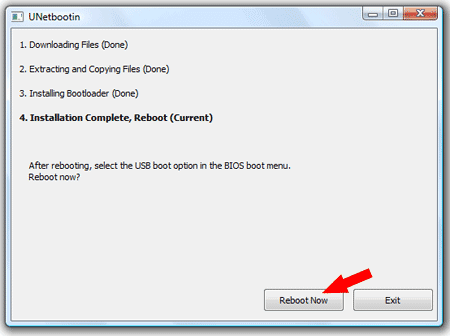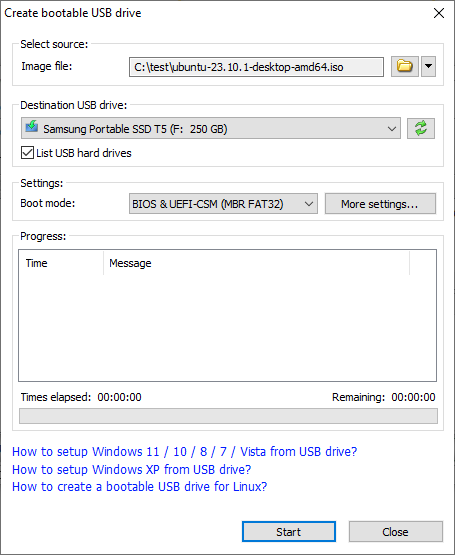

- #Install bootloader on usb linux how to
- #Install bootloader on usb linux install
- #Install bootloader on usb linux manual
- #Install bootloader on usb linux Pc
- #Install bootloader on usb linux iso
Even if something has gone wrong with that process, chances are you needn't perform every step described on this page.
#Install bootloader on usb linux install
Once you’ve installed Linux, it will install the Grub2 boot loader to your system.
#Install bootloader on usb linux how to
RELATED: How to Configure the GRUB2 Boot Loader's Settings Don’t tell the installer to take over an entire hard drive or replace Windows, as that’ll wipe away your existing Windows system.Ĭhoosing an Operating System and Customize Grub2
#Install bootloader on usb linux manual
This will look different depending on your Linux distribution, but you want to choose the option that lets you install Linux alongside Windows, or choose a manual partitioning option and create your own partitions. Go through the installer until you reach an option that asks where (or how) you want to install the Linux distribution. You may need to disable Secure Boot before installing Linux. Many Linux distributions will now boot normally on Secure Boot systems, but not all of them.
#Install bootloader on usb linux Pc
On some newer PCs, your PC may refuse to boot from the Linux installation media because Secure Boot is enabled. If not, you’ll need to change its boot order or use the UEFI boot menu to boot from a device. Reboot your computer and it should automatically boot from the Linux installation media you’ve inserted.
#Install bootloader on usb linux iso
You can download an ISO file and burn it to a disk or create a bootable USB drive. Next, make installation media for your Linux system. RELATED: How to Boot and Install Linux on a UEFI PC With Secure Boot You can then resize it normally, and BitLocker will be re-enabled on the partition after you reboot your computer. Instead, you’ll need to open the Control Panel, access the BitLOcker settings page, and click the “Suspend protection” link to the right of the encrypted partition you want to resize.

If you’re using BitLocker encryption on Windows, you won’t be abne to resize the partition. Right-click the Windows system partition - that’s likely your C:\ drive - and select “Shrink Volume.” Shrink it to free up space for your new Linux system. To do so, open the Disk Management utility - press Windows Key + R, type diskmgmt.msc into the Run dialog, and press Enter.

However, you may just want to shrink your Windows system partition from within Windows itself to avoid any potential problems. Most Linux installers allow you to resize Windows NTFS partitions, so you can do this during the installation process. Otherwise, it’s time to resize that existing Windows partition so you can make space for a new Linux partition.

If you already have some unallocated space or a separate hard drive for Linux, that’s perfect. You’ll probably want to resize your Windows system partition to make room for Linux. This will save you the trouble of resizing the partition later. If you’re setting up a PC from scratch, be sure to select the “Custom install” option and tell Windows to use only part of the hard drive, leaving some unallocated space left over for Linux. Your PC probably already has Windows installed on it, and that’s fine. RELATED: How to Install and Dual Boot Linux on a Mac Install Windows First It’ll automatically set up a Grub2 boot loader menu that lets you choose your preferred operating system each time you boot your computer.Īlthough the broad outlines are simple, this can be complicated by a number of issues including UEFI Secure Boot requirements on Windows 8 PCs and disk encryption. Boot from that drive and install it on your system, making sure you select the option that installs it alongside Windows - don’t tell it to wipe your hard drive. Install Linux Second: Choose your Linux distribution and put its installer on a USB drive or DVD.If you’re installing Windows from scratch, be sure to leave some free space on the drive for Linux. You’ll usually need to resize your Windows partition to make room for Linux. Make Room for Linux: You’ll need free space on your Windows system drive to install Linux, or possibly a second entirely different hard drive if you have a desktop PC.if you install Windows second, it will ignore Linux, and you’ll have to go through some trouble to get your Linux boot loader working again. If you install Linux second, it can set up its boot loader properly to happily co-exist with Windows. If not, be sure to install Windows first, before you install the Linux system. Install Windows First: If you already have Windows installed, that’s fine.Here’s the basic process you’ll need to follow:


 0 kommentar(er)
0 kommentar(er)
